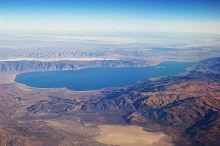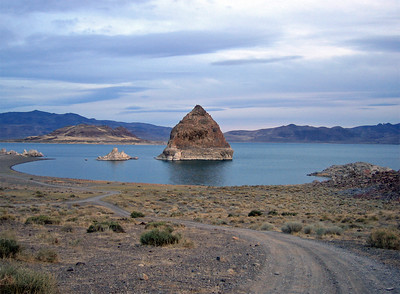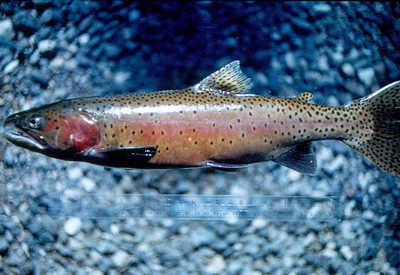
Look, I honestly didn’t plan it this way. But I know that people are going to open up this blog post and think to themselves, “Wow. This guy’s really got lakes on the brain.” Cross my heart, last week when I talked about all the non-Tahoe and non-Donner lakes here in the area, I didn’t know that Pyramid Lake was right on the cusp of opening up. But it’s OK because this is big news, and Pyramid Lake really deserves its own post anyway. So here’s the skinny, as per the press release issued by the Pyramid Lake Paiute Tribe. The lake is reopening to the public for fishing as well as camping, boating and day use as of November 2 with online permit sales and ranger station online sales only. State Route 446 will also reopen to the public on the same date. And in conjunction with the lake’s reopening, all sorts of COVID-19 protocols that you would expect to see will also be required such as social distancing, required masking and so on. As far as they apply to lake recreation, it means that camping will be limited to a max of three days with up to 10 people and up to two vehicles and up to one RV allowed at each campsite. Photo at left: Wikimedia Commons, Ron Reiring.
 For those who may not be as familiar with Pyramid Lake, it is located about 40 miles northeast of Reno-Sparks. You can get there by heading east on Interstate 80 toward Fernley and then north toward Nixon on Highway 447. Or for a more direct route, just shoot north through the Spanish Springs area on Highway 445, also aptly named Pyramid Highway. The lake itself lies entirely within the borders of the Pyramid Lake Paiute Indian Reservation, and at a surface area of some 125,000 acres is one of the largest natural lakes in the state. Sometime earlier this year, I wrote about how I learned in school up in the Northwest about the Continental Divide and that all water on the west side made its way to the Pacific, while all water on the eastern side eventually ended up in the Atlantic. As I noted, it turns out that my geography teacher neglected to cover our little patch of the country in our area here, where the waters from Tahoe feed into the Truckee River and flow into this sink in Nevada’s interior. And it just sits there in Pyramid Lake, all dressed up with no place to go other than to evaporate and begin the hydrological version of the circle of life all over again. As such, it’s also what’s left of Lake Lahontan, the huge body of water that covered a huge portion of the Silver State back when I was a kid, way back in the ice age of some 10,000 years or so ago.
For those who may not be as familiar with Pyramid Lake, it is located about 40 miles northeast of Reno-Sparks. You can get there by heading east on Interstate 80 toward Fernley and then north toward Nixon on Highway 447. Or for a more direct route, just shoot north through the Spanish Springs area on Highway 445, also aptly named Pyramid Highway. The lake itself lies entirely within the borders of the Pyramid Lake Paiute Indian Reservation, and at a surface area of some 125,000 acres is one of the largest natural lakes in the state. Sometime earlier this year, I wrote about how I learned in school up in the Northwest about the Continental Divide and that all water on the west side made its way to the Pacific, while all water on the eastern side eventually ended up in the Atlantic. As I noted, it turns out that my geography teacher neglected to cover our little patch of the country in our area here, where the waters from Tahoe feed into the Truckee River and flow into this sink in Nevada’s interior. And it just sits there in Pyramid Lake, all dressed up with no place to go other than to evaporate and begin the hydrological version of the circle of life all over again. As such, it’s also what’s left of Lake Lahontan, the huge body of water that covered a huge portion of the Silver State back when I was a kid, way back in the ice age of some 10,000 years or so ago.
 As for the fish in Pyramid Lake, the story is just as fascinating. Native species here include the Cui-ui, a large sucker fish that once made up a large part of the food supplies for the Paiute people but is now critically endangered. There are also the Tahoe Sucker and Tui Chubs in Pyramid Lake, but the show-stopper just may be the Lahontan Cutthroat. This trout used to be found throughout the Truckee River watershed, including in Lake Tahoe, but due to a number of contributing factors, hasn’t existed in the lake since in the 1930s. And for a final bit of interesting info, the lake gets its name from tufa or limestone formations in the area that are shaped like cones or domes or, well, like pyramids. The name used today obviously isn’t the same one by which it was known by the Paiute people but instead is the moniker hung on it by, guess who, frontier explorer John Fremont (there’s just no getting away from this guy, it seems). Photo at right: Flickr, CDFW file photo.
As for the fish in Pyramid Lake, the story is just as fascinating. Native species here include the Cui-ui, a large sucker fish that once made up a large part of the food supplies for the Paiute people but is now critically endangered. There are also the Tahoe Sucker and Tui Chubs in Pyramid Lake, but the show-stopper just may be the Lahontan Cutthroat. This trout used to be found throughout the Truckee River watershed, including in Lake Tahoe, but due to a number of contributing factors, hasn’t existed in the lake since in the 1930s. And for a final bit of interesting info, the lake gets its name from tufa or limestone formations in the area that are shaped like cones or domes or, well, like pyramids. The name used today obviously isn’t the same one by which it was known by the Paiute people but instead is the moniker hung on it by, guess who, frontier explorer John Fremont (there’s just no getting away from this guy, it seems). Photo at right: Flickr, CDFW file photo.
So there you have it. This is my last lake-oriented post for a while ... and I really mean that. (But do mark your calendars for some time about mid-January. Ice fishing, you know.)


 R. Keith Rugg has worked on staff for a number of local publications, including Lake Tahoe Action Magazine, the Tahoe Daily Tribune and the Reno Gazette-Journal.
R. Keith Rugg has worked on staff for a number of local publications, including Lake Tahoe Action Magazine, the Tahoe Daily Tribune and the Reno Gazette-Journal.

